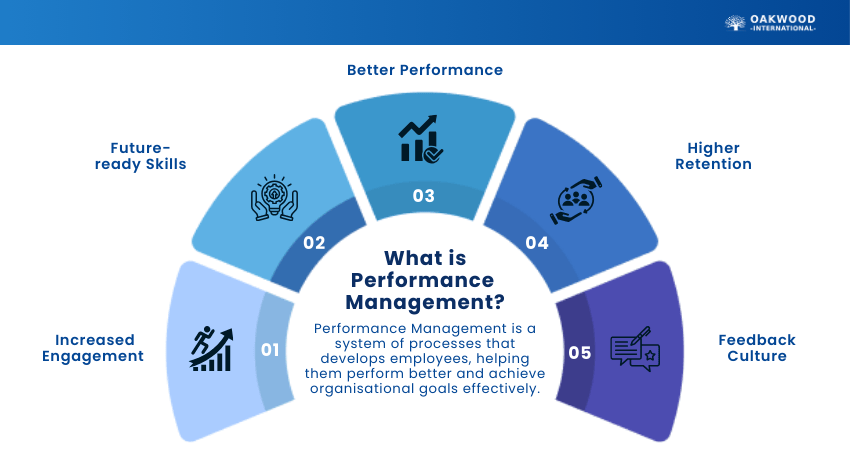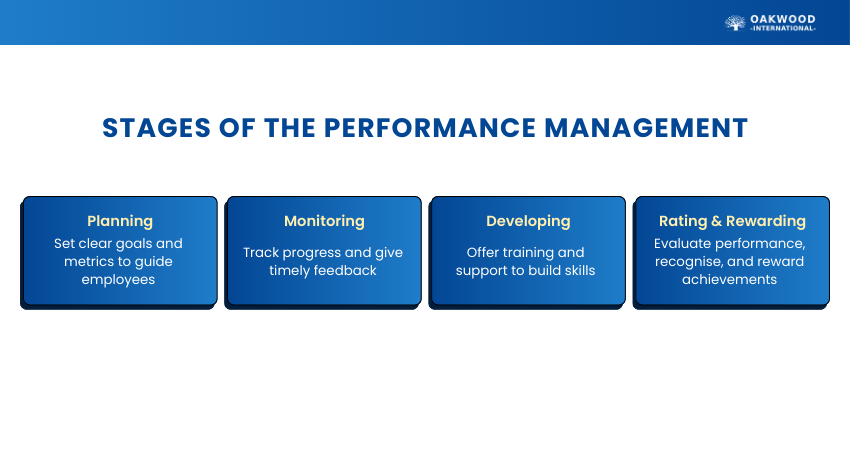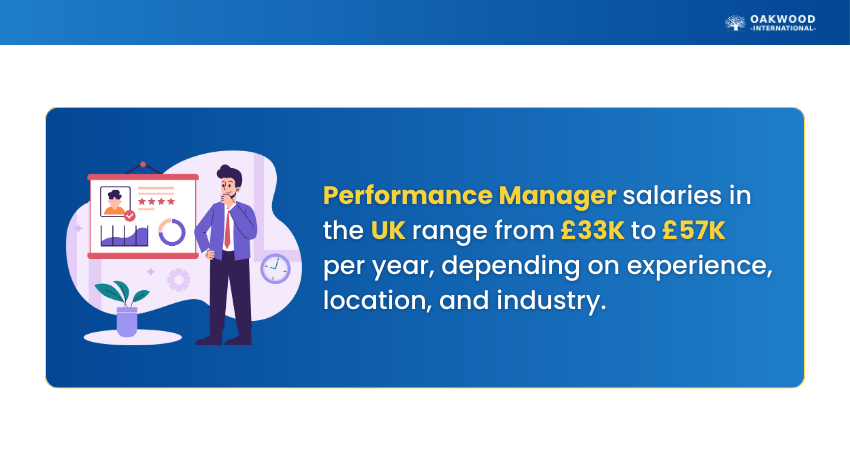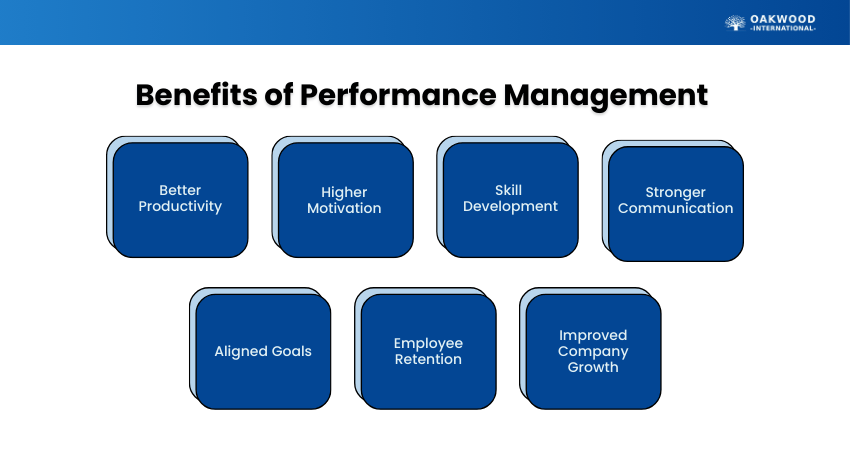Table of Contents


Ever wondered how Amazon manages to deliver millions of packages on time, every single day? It’s not luck, it’s the power of smart Performance Management. Every team knows exactly what to do, when to do it, and how to do it better. By setting clear goals, tracking progress, and improving constantly, Amazon turns complexity into efficiency, and success becomes inevitable.
In this blog, we’ll explore what Performance Management is, how it works, and why it matters. You’ll discover its features, stages, methods, and benefits. Also, best practices and real-world examples showing how top companies use it to stay ahead.
What is Performance Management?
Performance Management is an ongoing process where Managers and employees talk regularly to review job roles, expectations, performance, and growth plans. Its goal is to help employees do their best, ensure their work supports the company’s goals, and create a positive and satisfying workplace for everyone.

Unlike old-style annual reviews, modern Performance Management is continuous. It focuses on setting clear goals and providing regular feedback. Also, improving skills, and recognising achievements. The aim is to create a system where employees understand their role, stay motivated, and perform effectively.
How Does Performance Management Work?
Performance Management works by creating a continuous cycle where Managers and employees work together to set goals, track progress, and improve performance. It ensures that everyone’s efforts align with the company’s objectives. Here’s how it works step by step:
1) Setting Clear Goals:
Employees and Managers decide on specific, measurable, and realistic goals. Also, these goals give employees a clear direction.
2) Monitoring Progress:
Managers regularly track performance through check-ins, reports, or tools to ensure work stays on the right path.
3) Providing Feedback:
Employees receive regular feedback to understand what they’re doing well and where they can improve.
4) Employee Development:
Training, coaching, and learning opportunities are offered to improve skills and prepare employees for future roles.
5) Recognition and Rewards:
Good performance is acknowledged and rewarded, keeping employees motivated and engaged.
Enhance your talent strategy, attract, develop, and retain top talent fast with our Talent Management Training – Join now!
Why is Performance Management Important?
Performance Management is essential because it helps employees understand what is expected of them and how their work supports company goals. It gives Managers and employees a chance to talk openly and improve together.
With regular feedback and recognition, people feel valued and motivated to do their best. It also creates opportunities for learning and growth, preparing employees for future roles. Overall, it builds a positive workplace where everyone works towards success.
Stages of Performance Management
Performance Management usually follows four key stages:

1) Planning
This is the starting point. Managers and employees set clear, realistic, and measurable goals. Everyone should understand their roles and responsibilities.
Example:
Using the OKR approach followed by companies like Google, a Sales Executive sets a goal to close 15 enterprise deals in the next quarter.
2) Monitoring
In this stage, progress is tracked regularly. Managers hold weekly or monthly check-ins to ensure employees are on the right path.
Example:
Similar to Google’s weekly check-ins, the Sales Executive reviews progress with their Manager and adjusts strategies if results are below target.
3) Developing
If employees need support, organisations provide training, coaching, and mentorship. This helps them improve skills and perform better.
Example:
Following practices at organisations like Google, the Sales Executive attends a negotiation workshop and gets personal coaching to handle clients better.
4) Rating & Rewarding
Finally, Managers evaluate employee performance based on results and behaviour. High-performing employees are recognised and rewarded, while those needing improvement get personalised support.
Example:
Inspired by Google’s reward system, the Sales Executive who meets the 15-deal goal earns a bonus or promotion, while those falling short get feedback and guidance.
Streamline resources and align talent with goals with our Workforce Resource Planning Training – Join now!
Performance Management Methods
Companies use several Performance Management methods to support Employee Development, strengthen performance, and align work with organisational goals. These methods help teams stay focused, improve skills, and achieve better results. Below are some widely used Performance Management methods explained clearly.

1) Goal Setting
Goal setting with SMART criteria helps employees understand expectations and stay motivated. SMART goals are:
a) Specific
b) Measurable
c) Achievable
d) Relevant
e) Time bound
Clear goals help employees prioritise tasks and see how their work contributes to the company’s success.
2) Continuous Performance Management
Continuous Performance Management involves regular discussions about progress, challenges, and development needs. Instead of annual reviews, Managers give timely feedback throughout the year, improving communication, trust, and overall performance.
Benefits:
a) Stronger Manager and employee relationships
b) Early identification of problems
c) Support for ongoing development
Example: A Manager meets the team every month to review achievements and improvement areas.
3) Management by Objectives (MBO)
Management by Objectives sets goals that align with organisational priorities. Managers and employees define objectives together and review progress. It helps employees understand strengths, improvement areas, and support needs while identifying skill gaps.
Example: An HR Manager sets an objective to reduce employee turnover by 10 percent within six months.
4) 360-degree Feedback
360-degree Feedback collects input from Managers, colleagues, team members, and sometimes clients. It offers a full picture of an employee’s performance and behaviour. This method helps employees understand strengths, improvement areas, and opportunities for growth.
Example: A team leader receives feedback from their Manager, team members, and other departments.
5) Performance Appraisals
Performance Appraisals are structured reviews that take place yearly or several times a year. Managers assess achievements, challenges, and areas for development. Appraisals guide employees on their career path and help improve motivation and long-term performance.
Example: During an annual meeting, a Manager reviews an employee’s strengths and development goals.
6) Coaching
In Performance Management, coaching helps employees build skills through guided conversations. Managers support them in solving challenges and finding solutions, which boosts confidence, performance, and professional growth.
Example: A Manager provides coaching sessions to help an employee build leadership skills.
How to Improve the Performance Management Process?
To make Performance Management more effective, companies should focus on these key areas:
1) What Does Your Workforce Want from Performance Management?
Employees perform better when they get:
1) Clear Expectations: Knowing exactly what is expected of them.
2) Regular Feedback: Understanding what they’re doing well and where to improve.
3) Growth Opportunities: Getting chances to learn new skills and develop.
4) Recognition: Feeling valued and appreciated for their work.
2) Do you Deliver Continuous Performance Management?
Performance improves when companies:
1) Give Frequent Feedback: Helping employees stay on the right track.
2) Have Ongoing Conversations: Encourage open discussions about progress.
3) Identify Issues Early: Spotting problems before they become bigger.
4) Keep Employees Engaged: Making them feel connected and involved.
3) Do Managers Have the Right Tools and Support?
Managers work better when they have:
1) Goal-setting Tools: To set clear and measurable objectives.
2) Real-time Tracking: To monitor employee progress effectively.
3) Accurate Feedback Systems: To give timely and fair evaluations.
4) Modern Software: Tools like BambooHR, Lattice, and Workday make Performance Management easy and clear.
Enhance your appraisal skills and impactful feedback today with our Performance Appraisal Training – Join now!
Benefits of Performance Management
Performance Management helps team members understand their goals, build skills, and stay motivated while supporting the organisation’s success. Here are the key benefits.

1) Sets Clear Expectations
Performance Management helps team members understand what is expected of them. Clear goals and standards make daily tasks easier to prioritise and complete. When expectations are clear, people feel more confident and stay focused on the right work.
2) Encourages Continuous Feedback
In Performance Management, team members receive feedback throughout the year. Regular check-ins help them track progress, improve sooner, and stay focused on their goals, building trust and supporting better performance.
3) Boosts Motivation
Recognition and guidance help team members feel valued. When their work is noticed, they feel more motivated and engaged. In Performance Management, this support leads to better results, higher productivity, and stronger commitment to their roles.
4) Aligns Organisational and Employee Goals
Performance Management helps employees understand how their work supports the organisation. When team members see the impact of their contribution, they feel more involved and purposeful. This alignment helps everyone work toward the same outcomes.
5) Provides Clear Career Direction
Regular performance discussions help team members understand their strengths and improvement areas. In Performance Management, this clarity supports career growth and helps employees to gain new skills to advance in the organisation.
Benefits of Performance Management for Businesses
Performance Management helps businesses build stronger teams, improve results, and support long-term growth. Here is how it benefits organisations.
1) Strengthens Employee Engagement
Regular recognition and feedback help employees feel valued and engaged. When shared often, they boost motivation. A steady Performance Management process supports a positive work environment and encourages growth.
2) Identifies Areas for Skill Improvement
Regular reviews and feedback help businesses spot skill gaps early. Through effective Performance Management, companies can provide the right training and support. This helps employees improve and strengthen the overall skills of the team.
3) Improves Manager and Employee Connections
Frequent check-ins help Managers and employees build trust and communicate better. In Performance Management, these conversations allow employees to share challenges and progress. Over time, this improves teamwork and creates stronger relationships.
4) Improves Employee Retention
Employees remain longer in a company when they feel valued and see chances to grow. Performance Management supports this by recognising their efforts and helping them develop. This reduces turnover and saves the business time and money on hiring.
5) Drives Better Performance
Clear goals and regular feedback guide employees toward the right priorities. With the support offered through Performance Management, they improve their work and deliver better results, boosting productivity and overall business performance.
Transform your recruiting approach with our Talent Acquisition Training. Register now for better hiring results.
Challenges of Implementing Performance Management
Many organisations find Performance Management hard to implement. Although it supports growth, several challenges can affect its success. Here are the challenges:
1) Unclear Objectives: Sometimes goals are unclear or not aligned with the company’s direction, leaving employees unsure of what to work toward and slowing progress.
2) Bias and Unfair Assessments: Evaluations can feel unfair when personal preferences influence decisions, which harms trust and makes employees feel less valued.
3) Not Enough Feedback: Relying on yearly reviews is not effective. Without regular feedback, employees do not know their progress or what to improve, which limits real growth.
4) Poor Communication: If Performance Management is not explained well, employees may see it as negative or unnecessary. Clear communication helps them understand its value.
5) Lack of Support and Training: Managers may lack the skills to deliver effective feedback or coaching, and without proper training the system becomes less effective for employees.
6) Old or Manual Systems: Using outdated or manual systems makes the process slow and difficult. Modern tools make it easier to track goals and progress throughout the year.
7) Focus on Problems Instead of Development: Some systems focus on mistakes instead of improvement, which can leave employees discouraged and less motivated to grow.
8) Takes Too Much Time: Traditional performance reviews require a lot of time and effort. When the system is too time-consuming, Managers may avoid using it consistently.
Best Practices for Performance Management
To get the best results, companies should follow these practices for Performance Management:
1) A Well-designed Performance Management Strategy
Create a clear plan by:
1) Setting Clear Objectives: So, employees know what to achieve.
2) Defining Measurable Goals: Making progress easy to track.
3) Supporting Employees: Providing help and resources at every stage.
2) A Culture of Open and Effective Communication
Build a workplace where:
1) Feedback is Shared Openly: Employees and Managers talk honestly.
2) Two-way Conversations Happen: Both sides listen and understand each other.
3) Trust Grows Stronger: Open communication improves relationships and teamwork.
3) Continuous Monitoring
Keep track of performance regularly by:
1) Reviewing Progress Often: Checking if goals are being met.
2) Fixing Problems Early: Solving issues before they get bigger.
3) Using Tracking Tools: Dashboards and reports make monitoring easier.
Examples of Performance Management
These are examples of Performance Management:
1) HSBC
HSBC introduced an HR app that helps employees and Managers record achievements, share feedback, and manage goals. It supports flexible work, improves communication, and makes yearly reviews more accurate by tracking progress throughout the year.
2) Deloitte
Deloitte encouraged frequent check-ins focused on performance and priorities. Employees received personalised career plans and a career coach. Performance data helped identify trends, support underperformers, and show the impact of regular feedback.
3) IKEA
IKEA launched a coaching programme to build stronger leadership skills as part of its Performance Management approach. The training improved management scores from 60 to 90 percent, and departments with trained Managers saw a 5 percent increase in KPIs.
Conclusion
Performance Management is more than just tracking goals; it’s about creating a culture of growth, feedback and continuous improvement. By setting clear objectives, monitoring progress, and supporting Employee Development, businesses can boost productivity and engagement. When the employees feel valued and aligned with company goals, it drives success, growth and better performance for everyone.
Transform your management approach with growth, guidance, and real results. Join our People Management Courses now!


 Back
Back



 Back to Catagories
Back to Catagories





 + 44 7452 122728
+ 44 7452 122728










